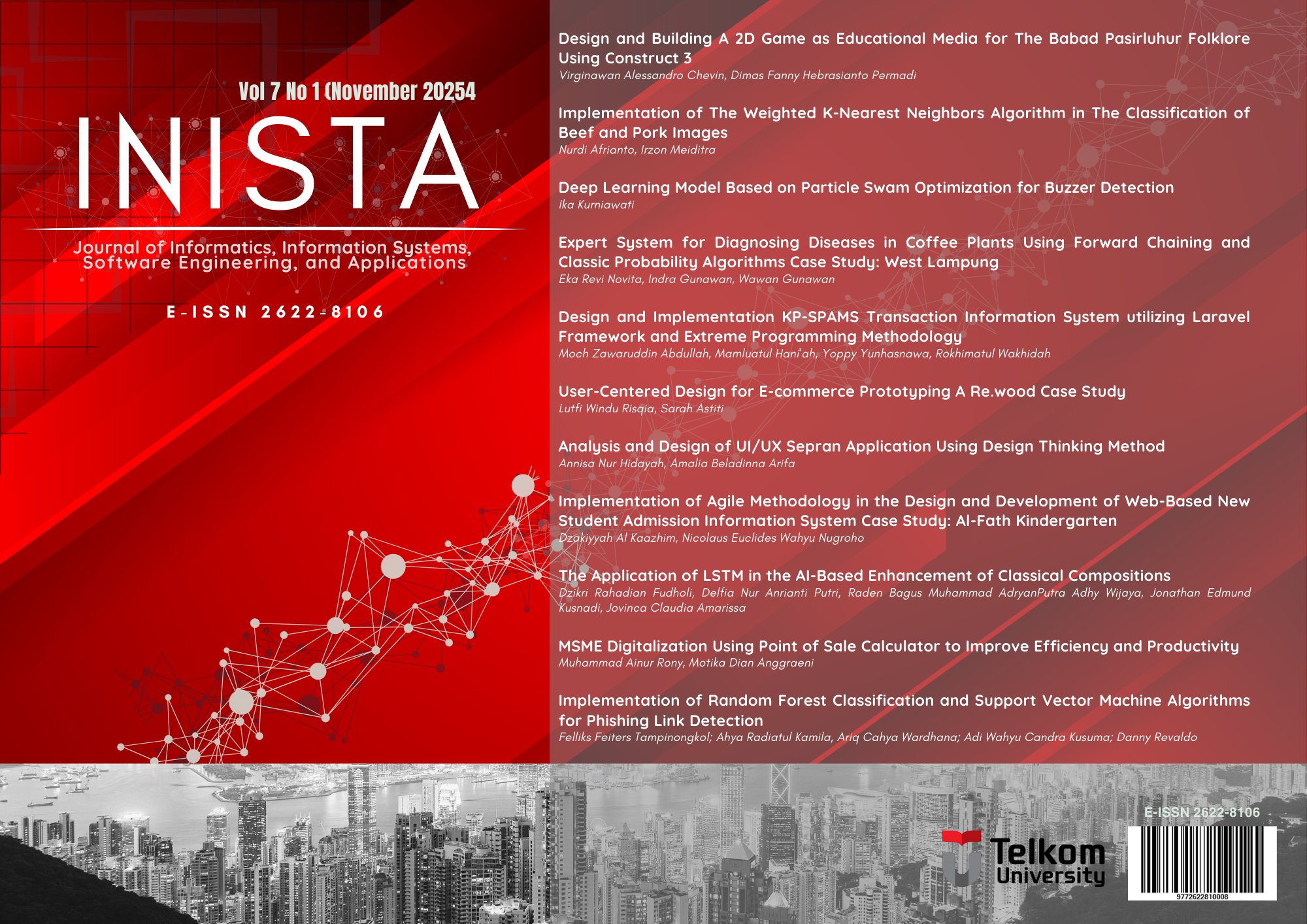Implementation of Agile Methodology in the Design and Development of Web-Based New Student Admission Information System Case Study: Al-Fath Kindergarten
Main Article Content
Abstract
The infrastructure supporting communities and educational institutions is necessary for the Industry 4.0 era to increase the productivity of educational institutions. The new student registration process at TK Al-Fath is still traditional. It has several shortcomings, such as repeated visits by parents during registration, repetitive information delivery, and unorganized documents, leading to difficulties in data summarization. A web-based system is required to assist TK Al-Fath and prospective students' parents in the new student admission process. This information system will be developed using the Agile development methodology, which will include stages of planning, implementation, software testing, documentation, and deployment. By applying the Agile methodology, the developed information system meets user needs and can be quickly adapted according to changes and feedback received during the development process. This system is limited to serving as an information and registration center, developed from observation, discussion, and literature study. In the final stage, Blackbox testing and User Acceptance Testing (UAT) were conducted. In the Blackbox testing, there were nine functionality testing scenarios, all of which resulted in a 'Successful' status after being tested by 20 respondents. The design and development of the Web-Based New Student Admission Information System at TK Al-Fath were completed and accepted by users, with a total UAT percentage of 93.58%, falling into the 'Very Good' category.
Article Details

This work is licensed under a Creative Commons Attribution-ShareAlike 4.0 International License.
Authors who publish with this journal agree to the following terms:
- Authors retain copyright and grant the journal right of first publication with the work simultaneously licensed under a Creative Commons Attribution License (CC BY-SA 4.0) that allows others to share the work with an acknowledgement of the work's authorship and initial publication in this journal.
- Authors are able to enter into separate, additional contractual arrangements for the non-exclusive distribution of the journal's published version of the work (e.g., post it to an institutional repository or publish it in a book), with an acknowledgement of its initial publication in this journal.
- Authors are permitted and encouraged to post their work online (e.g., in institutional repositories or on their website) prior to and during the submission process, as it can lead to productive exchanges, as well as earlier and greater citation of published work.
References
[2] W. Octaviani, “Mengapa 90% Sekolah Belum Memiliki Website”, Accessed: Dec. 26, 2022. [Online]. Available: https://www.exabytes.co.id/blog/sekolah-belum-memiliki-website/
[3] N. Cahya Dewi, Aslan, and M. Suhardi, “Gaya Kepemimpinan Kepala Taman Kanak-Kanak,” JMSP (Jurnal Manajemen dan Supervisi Pendidikan), vol. 4, pp. 1–6, 2020.
[4] N. Hasanah and N. Laily, “Self-Efficacy dan Kepuasan Kerja pada Guru Taman Kanak-Kanak (TK),” Efektor, vol. 7, no. 1, pp. 80–89, Jul. 2020, doi: 10.29407/e.v7i1.14398.
[5] A. Saputra and E. Filahanasari, “Pengembangan Media Video untuk Pengenalan Karir di Taman Kanak-Kanak,” JP2, vol. 3, no. 3, pp. 499–507, 2020.
[6] J. Hendra, G. Indra Putra, and P. Studi Pendidikan Jasmani Kesehatan dan Rekreasi STKIP Muhammadiyah Muara Bungo, “Mengembangkan Keterampilan Gerak Dasar Manipulatif Bagi Anak Melalui Permainan Olahraga Di Taman Kanak-Kanak,” Jurnal Muara Pendidikan, vol. 4, no. 2, 2019.
[7] R. I. Haryani, I. Jaya, and Y. Yulsyofriend, “Pembentukan Karakter Tanggung Jawab Di Taman Kanak-Kanak Islam Budi Mulia Padang,” Jurnal Ilmiah Potensia, vol. 4, no. 2, pp. 105–114, Jul. 2019, doi: 10.33369/jip.4.2.105-114.
[8] S. Ardy Nuswantoro and Suriansyah, “Rancang Bangun Sistem Informasi Pendaftaran Siswa Baru Berbasis Web”.
[9] A. Prasetya Putra, N. Azizah, and H. Saputro, “1 st Seminar Nasional dan Prosiding Scitech 2022 Fakultas Sains dan Teknologi Jepara,” 2022, [Online]. Available: https://conference.unisnu.ac.id/scitech
[10] K. Anwar, L. D. Kurniawan, M. I. Rahman, and N. Ani, “Aplikasi Marketplace Penyewaan Lapangan Olahraga Dari Berbagai Cabang Dengan Metode Agile Development,” Jurnal Sisfokom (Sistem Informasi dan Komputer), vol. 9, no. 2, pp. 264–274, Aug. 2020, doi: 10.32736/sisfokom.v9i2.905.
[11] J. Saputra Irsandi, I. Fitri, N. D. Nathasia, and K. Kunci, “Sistem Informasi Pemasaran dengan Penerapan CRM (Customer Relationship Management) Berbasis Website menggunakan Metode Waterfall dan Agile,” Jurnal Teknologi Informasi dan Komunikasi), vol. 5, no. 4, p. 2021, 2021, doi: 10.35870/jti.
[12] C. Fitriana, L. Listiyoko, P. Surya, A. Maksum, and A. Fahrudin, “Perancangan Aplikasi Point of Sales Berbasis Web Untuk Efisiensi Antrean Pada Restoran Serba Sambal,” Jurnal Komputer dan Informatika, vol. 15, pp. 149–158, 2020.
[13] I. K. Raharjana, Pengembangan Sistem Informasi Menggunakan Metodologi Agile, 1st ed. Sleman, Yogyakarta: Deepublish, 2017.
[14] R. Wicaksono and U. Chotijah, “Sistem Informasi Tagihan Hippam Desa Leran Berbasis Website Dengan Metode Agile Software Development.”
[15] A. Yauma, I. Fitri, and S. Ningsih, “Learning Management System (LMS) pada E-Learning Menggunakan Metode Agile dan Waterfall berbasis Website,” Jurnal Teknologi Informasi dan Komunikasi), vol. 5, no. 3, p. 2021, 2021, doi: 10.35870/jti.
